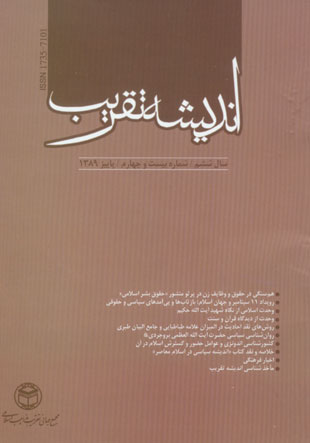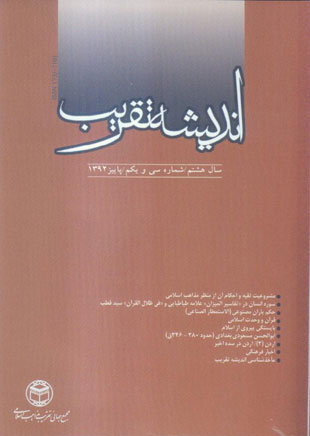فهرست مطالب

فصلنامه اندیشه تقریب
پیاپی 24 (پاییز 1389)
- 244 صفحه،
- تاریخ انتشار: 1389/12/20
- تعداد عناوین: 14
-
صفحه 5
- مقالات اندیشه ای
-
صفحه 69
- پیشگامان تقریب
- سرزمین های جهان اسلام
- گزارشی از یک کتاب
-
صفحه 187
- ماخذشناسی اندیشه تقریب
-
صفحه 231
-
چکیده مقالات به زبان انگلیسیصفحه 244
-
Page 11Today, one of the most controversial issues in human rights discussions is equality of men and women’s rights. The key point is the difference between Islamic viewpoint and other viewpoints. The question is whether ‘equal rights’ is the same as similarity betweenthem or if it means ‘equality in rights and responsibilities’? Acknowledging existence of differences in some of the rights and responsibilities of men and women, the author emphasizes that there is no difference between men and women in terms of basic andhuman rights; and if the existing differences, originating from their natural characters, are assessed in accordance with their rights and responsibilities, then the balance between their rights and responsibilities will be clarified. To achieve this purpose, the presentpaper analyses various factors of ‘Islamic charter of human rights’ and in the end the author discusses the role of women in the process of social development and in the realization of Islam civilization plan.
-
Page 35Since 11th of September 2001, several papers and books have been written about this important event that happened at the beginning of the third millennium. Different dimensions of this event are still discussed and criticized internationally and within the Islam world after 9 years. It has undeniable impacts on the country where it happened, international relations, international law and Islam world. This paper attempts to assess some of the political and legal aspects of this happening within international level as well as the world of Islam. This is conducted in two sections:a. impacts of 11th of September on international level and the world of Islam b. effects of 11th of September upon international relations and laws as well as the world of Islam
-
Page 55Shahid Ayatollah Syed Muhammadbagher Hakim is an Islamic scholar who has had an effective role in disseminating and introducing the theory of Islamic unity and the culture of cohesion. In his viewpoint, an Islamic unity which is formed based on commonalities and principles of all creeds and the one which is in accordance with the Quran and sayings of the Prophet (a.s) and the Imams (a.s) will be accepted by all the Muslims. He ranked Islamic unity in the third place of priorities after ‘principles of belief’ and ‘protection of political integrity’ and described it as the first step toward achieving unity among Islamic creeds. The most important underpinnings of ‘Islamic unity theory’ are the Quran and theviewpoints of the Prophet (s.a) and the Ahl-e Bayt (a.s). Shahid Hamik has had socio-political approach in his activities regarding Islamic unity; this approach reflects Hakim’s practical viewpoints concerning unity. The issue of Iraqi Muslims’ unity against Ba’athRegime, based on the unity of the righteousness against wickedness, was a clear example of Shahid Hakim’s activities concerning unity.
-
Page 69Having faith in monotheism, one source of creation, Islam, Quran and tradition (of the Prophet (s.a) and of the Imams (a.s) are crucialprinciples of unity. Some of the outstanding and effective factors for achieving unity are namely, divine piety, friendship between Muslims and others, cohesive community, and faith in God.According to the viewpoint of the Prophet’s (s.a) traditions it is advisable to follow the Ahl-e Bayt (a.s); such following is the means for achieving Islamic unity. Imam Ali (a.s) describes ‘tradition of the Prophet (a.s)’ as ‘a major factor for creating Islamic unity’ and calls for Muslims to unite and have good moral, etc. The external factors against unity of Muslims are domination of the West and conspiracy of colonizers and the internal factors are Muslims’ negligence, internal dictatorship, cultural and economic weaknesses andnationalism. Some of the key elements which create unity are namely having faith in God, moving toward God, holding dialogues and conducting academic, research studies, and having attention to Islamic commonalities and humanities.
-
Page 97Quotations written during the time of the Prophet (s.a), the disciples and the followers about of the events and Ahadith that were quoted during their times are one of the most reliable sources of Quran exegesis, thus special efforts should be devoted for identifying and validating them in order for the exegesis to become more reliableand more authenticated. This paper introduces the criteria applied by Alame Tabatabaei and Tabari concerning critiquing Ahadith. The criteria are different; a group of criteria are exclusively used by Alame Tabatabaei (i.e. attention to jarye, comparison and attention tothe reporter’s Ijtihad and deduction) and Alame Tabari (i.e. using the prevalent method used by Arabs for expressing and applying Arabs’ common words); the other criteria are used by the majority of the Quran interpreters when explaining the Quran, such as reasoning and academic standard.
-
Page 119This paper assesses character and political psychology of Grand Ayatollah Brujerdi, one of the Marja’e in Shiite Imamiyye, according to the theory of Abraham Maslow. Due to the ‘basic concepts’ of this theory, which is studying the best human sample i.e. the mostinnovative one, the most decent and grown human is employed in order to discover the human nature. Different aspects of Grand Ayatollah Brujerdi’s life, including his childhood, education and during his Marja’iyat time that are filled with several lessons andinspirations are studied. Ayatollah Brujerdi is referred to by Maslow as a perfect example of an academic, decent, refined and well-known person.
-
Page 135Indonesia is an Islamic country with the largest Muslim population. The country has a special climate and geography and consists of small and large islands extending in a line in south east of Asia. The Shafe’i Muslims living in these islands used to be colonized by Netherlands, Portugal and other countries. Great waves of Islam seeking and Islamic awakening encouraged Indonesians’ Muslims to stand against and fight with the foreigners and they made several revolutionary movements to achieve independence. They finally succeeded and introduced to the world their independent country on August 1945. After learning a short introduction about Indonesia’s Geography, culture, economy and religion, this paper attempts to briefly explain the history of Indonesia in the pre-Islam era and discuss the factors causing expansion of Islam in Indonesia so that this Islamic country is better recognized.


